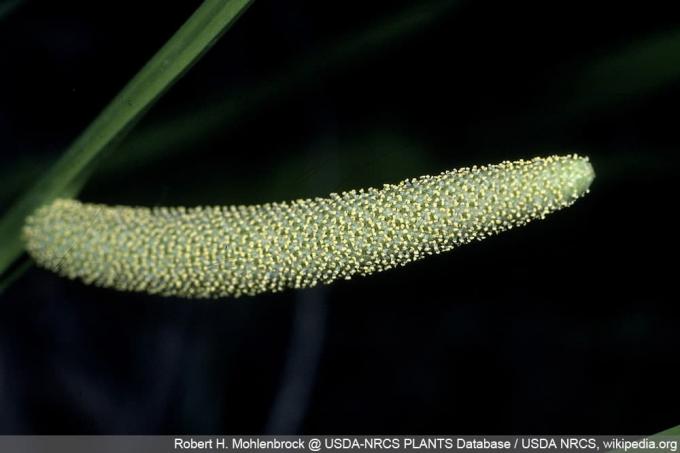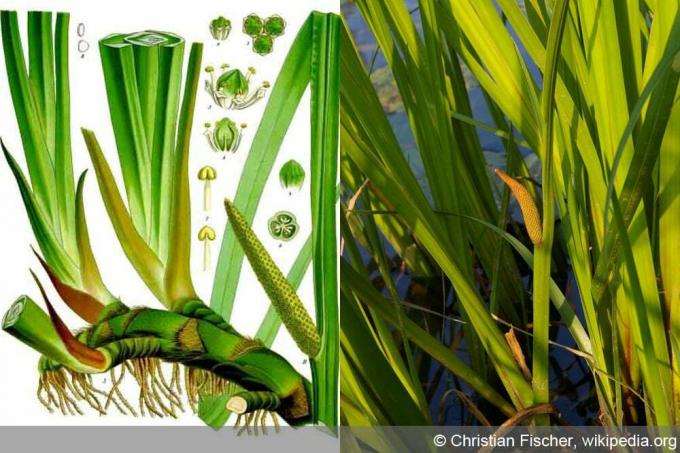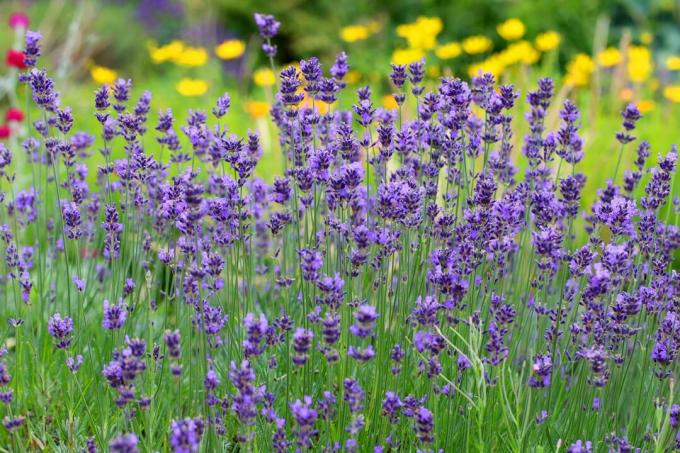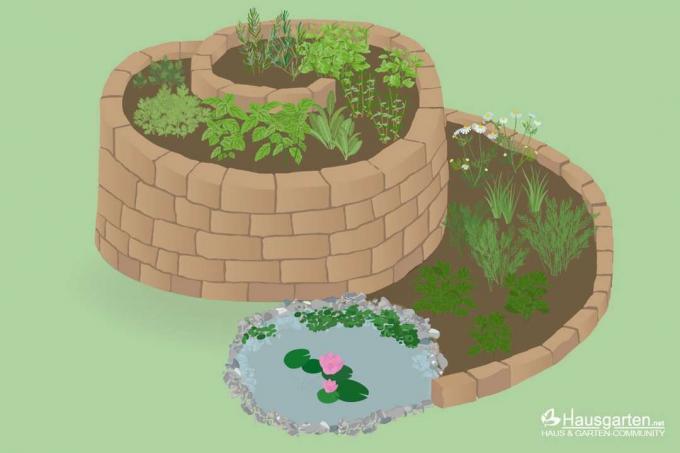

Table of contents
- Location
- substrate
- watering and fertilizing
- cultivation
- Cultivation in the bucket
- multiply
- Cut
- hibernate
- use
- Control diseases and pests
- Conclusion
Ackermann, gastric root, German ginger or zedoary - hardly any other plant has as many popular names as sweet flag. The Asian plant conquered in the 16th Century Central Europe and was cultivated in many gardens as a medicinal herb until a few decades ago. In the meantime, many gardeners have come to appreciate the virtues of Acorus calamus as a companion plant for swamp beds and ponds. The cultivation and care of the water-loving perennial are easy and succeed without much effort.
Location
Acorus calamus is an interesting plant that has many uses in home gardens. The plant with the bulb-like flowers originally comes from Asia and is mainly found on bank edges and in swampy areas. In order to optimally promote the growth of the up to 100 cm high perennial, the sweet flag should be provided with similar conditions in our latitudes. The edges of ponds and small streams have proven themselves for this task. The large varieties of "common sweet flag" are suitable as decorative and discreet background planting. In the swamp zone of herb spirals, the smaller varieties, such as the white-striped calamus, come into their own.
- The location should be bright.
- Avoid dark, shady places.
- Kalmus needs a minimum distance of approx. 60 cm.
Provided there is sufficient moisture and the rhizome roots do not dry out, older specimens can cope with a location in full sun. The strong midday sun can cause significant damage to younger plants. Protect the calamus or make sure that the plants are only exposed to direct sunlight in the morning and afternoon.
When choosing the planting site, you should take into account the strong expansion of the perennial plant. The German Zitwer, as Kalmus is alternatively called, is undemanding and tends to grow strongly. To make access and care for the plant easier, you should cultivate the Asian perennial in an easily accessible place. With a bucket, calamus can be kept in check to some extent. In this way, you can also plant the plant with the grassy leaves in small gardens. A pond is not absolutely necessary.
substrate
Rich in humus and moist – the soil for sweet flags should meet these requirements. With a pH value between 6 and 7, the plant feels good and develops its rhizome-like roots. Obstacles, such as the rootstock of nearby plant neighbors, are pushed aside. A coarse-grained soil, such as that used in gravel beds, is unsuitable for Acorus calamus.
- The soil should have a light sand or have peat content.
- A drainage is not necessary.
- Small amounts of lime are tolerated.
Sweet flag plants in tubs need a similar substrate. Normal potting soil from the trade is suitable. Mix in a handful of sand, hummus and clay. If you are not cultivating the Asian plant for culinary purposes, you can grow the perennial in hydroponics. Instead of organic soil, the substrate in this particular case is made of an inorganic material. Expanded clay, basalt and gravel, for example, can be used for this task. Mineral wool and styrofoam flakes have also proven their worth. The advantage of hydroponics: The plants have large amounts of water available in the pots. Regular watering checks are no longer necessary. At the same time, you do not have to rely on a special composition or Pay attention to the consistency of the soil.
watering and fertilizing

H. Zell, Acorus calamus 002, edited by Hausgarten, CC BY-SA 3.0.
While many garden plants are sensitive to "wet feet" and excess irrigation and rainwater have to drain off quickly, sweet flags cannot be moist enough. The reed-like plant feels at home on the banks of swamps and ponds. The stalks of the perennial perennial can be covered with water by a centimeter without the ascomycetes causing the root rot in the exotic plants that gardeners fear. The dense network of roots of the calamus must not dry out. If the perennial herbaceous plant is planted in normal soil, you should regularly check the moisture in the substrate on hot summer days. Even short periods of drought can damage the plant.
Sweet flag plants need sufficient nutrients from March to September. In the garden pond, this takes place via the minerals and algae dissolved in the water. In addition, a special fertilizer ensures that the water and marsh plants are supplied with the necessary substances.
- In spring and late summer, mulch the beds and work in compost.
- Use liquid fertilizer for potted plants every 3 to 4 weeks.
- There is no fertilization during the winter months.
Discolored and drooping leaves are in some cases an indication of a nutrient deficiency. Fertilize immediately so as not to weaken the perennial even further. Newly created ponds and swamp zones lack the important microorganisms in the water, which supply the plants with minerals. In the early days, use a special product from a specialist retailer.
cultivation
It is a myth that calamus belongs to the arum family. The perennials belong to the sweet flag family (Acoraceae) and eating the parts of the plant does not cause severe symptoms of poisoning. The reed-like reed plants have a large number of important ingredients that can be found in dried or dried form. ground form can be used. The cultivation or the marsh plants are planted in spring. Only a few varieties of calamus are hardy, especially young or newly planted plants are not yet able to adequately protect themselves from frost and sub-zero temperatures. If you have the opportunity, you should plant calamus in the riparian zone of a garden pond.
- Acorus calamus can be planted in a water depth of 10-15 cm.
- When planting in groups, the minimum distance of 60 cm can be undershot.
- A pot for pond plants prevents the perennials from spreading too much.
The plants should not come into direct contact with the pond liner to avoid damaging it. With coarse gravel you can effectively prevent koi or koi from getting caught. other curious water dwellers expose the roots of the plants. Sweet flag can easily be combined with other pond plants such as marsh marigolds and sedges.
Cultivation in the bed is simple:
- Dig a planting hole.
- This should have twice the circumference of the roots of the calamus plants.
- Loosen the surrounding soil sufficiently.
- Prepare substrate with clay, sand or peat.
- Spread compost in the planting hole.
- Use calamus up to the upper root neck.
- Fill cavities with soil and press down.
- Pour vigorously.
Tip:
Plant calamus in a small depression where irrigation and rainwater can stay for a longer period of time.
Cultivation in the bucket
You can keep calamus in a large container all year round without any problems. The care differs only slightly from the plants in the field. The advantage: Tub plants can be moved if necessary. In this way, the sweet flag is suitable as a decorative planting for terraces and arbors. With a growth height of over 100 cm, the plant can be used as a privacy screen. If the container doesn't have drainage holes at the bottom, you can turn the container into a "mini pond". Change the water at irregular intervals to prevent rot and mosquito larvae.
Sweet flag does not need a drainage made of porous material, as is usual with other plants. Rather the opposite is the case, the valuable moisture should be retained in the vessel. Instead of a small "pond" you can opt for a large coaster or fall back on planter. Approximately every 2 years the marsh plants need a larger bucket. Alternatively, you can rejuvenate the perennial by root division.
multiply
You have to take care of the spread of Acorus calamus yourself at the same location, unless you created a rhizome barrier when planting. Under optimal care conditions, the distinctive plant can expand greatly in width. If you want controlled propagation, the following tips apply:
- Dig up older, large plants in spring.
- Use an ax to cut the calamus root ball into evenly sized pieces.
- Insert the individual parts as usual.
In our latitudes it is almost impossible to harvest germinable seeds from the calamus plants. Access root division or to plants from the garden trade.
Cut

Christian Fischer, AcorusCalamus, edited by Hausgarten, CC BY-SA 3.0.
The “German ginger” is summer green. In autumn, the grassy leaves wither and turn a drab brown hue. The foliage is only pruned in the spring. In regions with mild winters, it is possible for the sweet flag plants to hibernate in the garden. The foliage is tied together and protects the root ball from cold and frost in the cold season. Unwelcome and disturbing single shoots can be removed close to the ground at any time during the main growing season.
hibernate
The Asian swamp plants cannot cope with sub-zero temperatures. If the thermometer drops below 5°C, sweet flag stops growing and the dormant phase begins. If you have the opportunity, you should move the perennials to a frost-proof, bright room in autumn.
- The winter quarters should have a temperature between 5° - 10° C.
- Avoid sources of heat and direct sunlight.
- The root ball should not dry out even in winter.
You can spread a thick layer of bark mulch and a warm fleece in the bed to protect the plants from freezing completely. The leaves are loosely tied together.
use
In Asia, calamus is grown not only as an ornamental plant, but also as a useful medicinal herb. The plant is said to help with stomach and digestive problems, has an anti-inflammatory effect and stimulates the appetite. The essential oils are used as tea and tincture. In China, the perennial has been used as a life extender since 3700 BC. It is the underground shoots, colloquially referred to as rhizome roots, that are used in the kitchen. The plant parts are cut into small pieces, peeled and dried.
The consumption of calamus in any form should be enjoyed with caution. A few ingredients have a mild hallucinogenic effect. For this reason, the entire plant was classified as slightly poisonous. If you want to process the plant for your pantry, you should, in the interest of your own health, deal with the exact amount and application thoroughly. The function of sweet flag as a filter feeder is interesting for pond owners. The swamp plants not only look distinctive in the bank area, they also reduce the harmful substances in the water. In this way, the pond is enriched with oxygen and the risk of algae is minimized.
Control diseases and pests
If the requirements in terms of care and location are met, harmful insects and diseases do not play a special role in Acorus calamus. Even snails avoid the grassy leaves of the perennial. Drought and full sun are the only factors that can affect the Asian plant. In a warm winter quarters, the likelihood of sweet flag being infested by spider mites also increases. A web-like, fine web and a sticky surface give away the pests even before you see them. The following countermeasures have proven effective in combating this:
- increase humidity.
- set sticky traps.
- Wash heavily affected areas with soapy water.
- Remove shoots completely in case of overpopulation.
The plant parts should be disposed of with household waste, where the pests cannot spread. Complete pruning of the foliage does not harm the plant itself.
Conclusion
Sweet flag is a versatile and robust plant that brings visual accents to the garden. Versatile and healthy, the bitter marsh plant forgives many care mistakes. In addition to its culinary benefits, the aromatic perennial can be used as a decorative privacy screen and to border ornamental beds and ponds.
 garden editorial
garden editorial I write about everything that interests me in my garden.
Learn more about growing herbs

Basil has black dots: what to do?
Especially basil bought in a pot from the supermarket tends to quickly develop black dots or spots on the leaves. This article explains why this is and what helps against it.

14 kitchen herbs that you can really keep in the kitchen
Sometimes a herb garden is only possible on the windowsill. If you don't have your own garden bed, for example, or in the months when the frost freezes the coveted greenery outside. Our list provides an overview of which herbs like the kitchen location permanently.

Parsley turns yellow: Four tips against yellow leaves
If the leaves of the parsley suddenly turn yellow, the so-called parsley disease is usually behind it. This can have many causes. If the outbreak of the disease is to be prevented, only prevention helps. More about this here.

You can combine lavender with these 13 plants
Whether you use it in the kitchen, want to enjoy its fragrance or its beauty, lavender is a must in any garden. Well combined, it can strengthen other plants or protect them from pests. We present the best plant neighbors.

8 tips for cutting and harvesting herbs properly
Fresh herbs from the garden should not be missing in any kitchen. They are versatile, exude pleasant and spicy scents and are a treat for the eye with their pretty flowers. In the kitchen, they can easily replace artificial flavor enhancers.

Herb spiral & herb snail: this is how it's done
A herb spiral or herb snail makes it possible to plant many different varieties in a particularly decorative way. However, this is not the only advantage of these variants of the culture. You can find out how to create them here.

